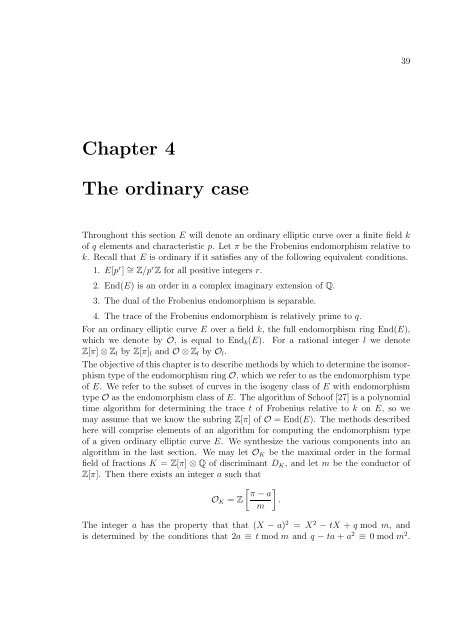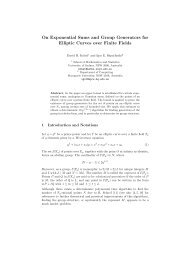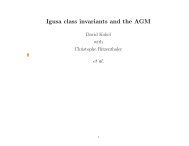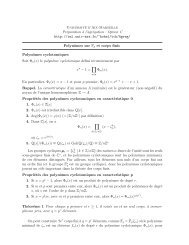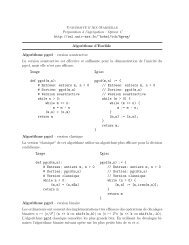Endomorphism rings of elliptic curves over finite fields by David Kohel
Endomorphism rings of elliptic curves over finite fields by David Kohel
Endomorphism rings of elliptic curves over finite fields by David Kohel
Create successful ePaper yourself
Turn your PDF publications into a flip-book with our unique Google optimized e-Paper software.
39Chapter 4The ordinary caseThroughout this section E will denote an ordinary <strong>elliptic</strong> curve <strong>over</strong> a <strong>finite</strong> field k<strong>of</strong> q elements and characteristic p. Let π be the Frobenius endomorphism relative tok. Recall that E is ordinary if it satisfies any <strong>of</strong> the following equivalent conditions.1. E[p r ] ∼ = Z/p r Z for all positive integers r.2. End(E) is an order in a complex imaginary extension <strong>of</strong> Q.3. The dual <strong>of</strong> the Frobenius endomorphism is separable.4. The trace <strong>of</strong> the Frobenius endomorphism is relatively prime to q.For an ordinary <strong>elliptic</strong> curve E <strong>over</strong> a field k, the full endomorphism ring End(E),which we denote <strong>by</strong> O, is equal to End k (E). For a rational integer l we denoteZ[π] ⊗ Z l <strong>by</strong> Z[π] l and O ⊗ Z l <strong>by</strong> O l .The objective <strong>of</strong> this chapter is to describe methods <strong>by</strong> which to determine the isomorphismtype <strong>of</strong> the endomorphism ring O, which we refer to as the endomorphism type<strong>of</strong> E. We refer to the subset <strong>of</strong> <strong>curves</strong> in the isogeny class <strong>of</strong> E with endomorphismtype O as the endomorphism class <strong>of</strong> E. The algorithm <strong>of</strong> Scho<strong>of</strong> [27] is a polynomialtime algorithm for determining the trace t <strong>of</strong> Frobenius relative to k on E, so wemay assume that we know the subring Z[π] <strong>of</strong> O = End(E). The methods describedhere will comprise elements <strong>of</strong> an algorithm for computing the endomorphism type<strong>of</strong> a given ordinary <strong>elliptic</strong> curve E. We synthesize the various components into analgorithm in the last section. We may let O K be the maximal order in the formalfield <strong>of</strong> fractions K = Z[π] ⊗ Q <strong>of</strong> discriminant D K , and let m be the conductor <strong>of</strong>Z[π]. Then there exists an integer a such that[ ] π − aO K = Z .mThe integer a has the property that that (X − a) 2 = X 2 − tX + q mod m, andis determined <strong>by</strong> the conditions that 2a ≡ t mod m and q − ta + a 2 ≡ 0 mod m 2 .


